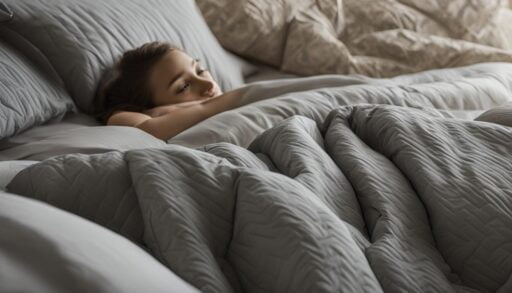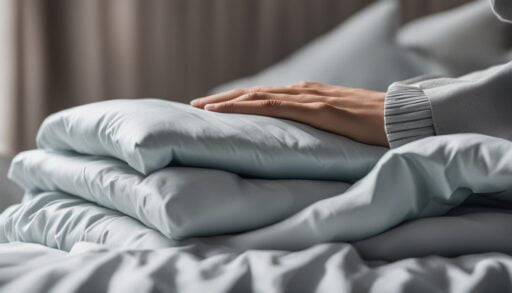Moonlit Tales: Discover the Magic of Enchanting Stories
Welcome to the enchanting world of Moonlit Tales Magic! Have you ever longed to immerse yourself in bedtime stories that transport you to a realm of magic, adventure, and innocence? Look no further! Moonlit Tales is a collection of forgotten narratives that capture the imagination and revive the joy of storytelling.
These tales, once lost to time, brim with supernatural elements and mythical creatures, taking you on captivating journeys through haunting legends and otherworldly folklore. Prepare to be mesmerized as you rediscover the enchanting narratives that have been tucked away and forgotten.
Key Takeaways:
- Indulge in the magic of Moonlit Tales through forgotten bedtime stories.
- Experience the thrill of adventure and the innocence of childhood in these captivating narratives.
- Rediscover ancient myths, supernatural creatures, and haunting legends.
- Immerse yourself in the enchanting world of Moonlit Tales and embrace the joy of storytelling.
- Let the forgotten tales transport you to a realm of wonder and ignite your imagination.
The Importance of Medtner’s Fairy Tales in Russian Music
Medtner’s Fairy Tales hold a significant place in Russian music. Composed in ten collections known as “skazki,” these pieces draw inspiration from Russian folklore and feature magical and supernatural elements. Unlike English fairy tales, Medtner’s works portray the portrayal of human subjects in day-to-day activities. The lack of an explicit story allows the audience to use their imagination, a characteristic that distinguishes Medtner’s Fairy Tales. These works are considered an extension of the popular movement in late nineteenth-century Russian music that incorporated folk elements.
The Magical Influence of Russian Folklore
Russian folklore has always played a vital role in the artistic expression of the country, including its music. Medtner pays homage to this rich cultural heritage by infusing his Fairy Tales with themes, melodies, and rhythms reminiscent of traditional Russian folk songs. This connection to the roots of Russian music gives his compositions a sense of nationalistic pride and authenticity, resonating deeply with audiences familiar with the country’s folklore.
The Power of Storytelling through Music
Medtner’s Fairy Tales showcase the power of storytelling through music. In these pieces, the absence of spoken words allows the music to communicate the narrative, emotions, and even the fantastical elements of the tales. This unique approach to storytelling captivates listeners, inviting them to embark on a journey of imagination and interpretation. Each listener can weave their own story within the framework of the music, creating a deeply personal and immersive experience.
Furthermore, Medtner’s Fairy Tales serve as a testament to the enduring allure of storytelling itself. They remind us of the timeless power of narratives to capture our imagination, evoke emotions, and transport us to other worlds. In a society where stories have been passed down through generations, Medtner’s compositions continue this tradition, preserving and celebrating the art of storytelling in a musical form.

Conclusion
Medtner’s Fairy Tales are not simply musical compositions; they are gateways to the rich tapestry of Russian folklore and storytelling. Through these enchanting pieces, listeners can explore the depths of human emotions, embark on magical journeys, and connect with the cultural heritage of Russia. Medtner’s Fairy Tales serve as a testament to the power of music to evoke emotions, ignite the imagination, and preserve the beauty of storytelling for generations to come.
The Journey of a Filmmaker – From Loss to Creative Rediscovery
Embarking on a filmmaking journey is a rollercoaster ride, filled with highs and lows, triumphs and setbacks. For one filmmaker, this journey took an unexpected turn when a devastating loss threatened to shatter his dreams. In the face of adversity, however, he found solace and new inspiration, leading to a remarkable rediscovery of his creative passion.
It all began when his film, two years in the making, was stolen. The pain of losing not only his hard work but also his vision and dreams was indescribable. He felt like a failure, questioning his abilities and doubting whether he could ever create something meaningful again.
But amidst the wreckage, a glimmer of hope emerged. The filmmaker decided to rewrite the stolen script as a book, pouring his heart and soul into the pages. As he delved into the world of storytelling through writing, he discovered a renewed sense of purpose and a deep connection to his craft. The pain of loss transformed into a catalyst for creative exploration.
The transformative power of storytelling
“Storytelling is not limited to a single medium; it can take many forms and touch people’s hearts in different ways.”
Through this journey of creative rediscovery, the filmmaker realized that storytelling is not limited to a single medium; it can take many forms and touch people’s hearts in different ways. The power of storytelling lies not only in the final product but also in the process of creation and the impact it has on both the creator and the audience.
By exploring new avenues for expression, the filmmaker opened himself up to new possibilities and discovered a resilience he never knew existed. He learned that setbacks and losses are not the end but opportunities for growth and transformation.
Ultimately, this filmmaker’s journey serves as a reminder that creativity knows no bounds and that even in the face of loss, there is always a path towards rediscovery and renewal.

| Key Takeaways |
|---|
| Loss can be a catalyst for creative exploration and rediscovery. |
| Storytelling can take many forms and touch people’s hearts in different ways. |
| Setbacks and losses can lead to growth and new opportunities. |
Creating Intimate Connections Through Bedtime Stories
Bedtime stories have a unique ability to create intimate connections between partners. The simple act of reading aloud to your sweetheart can bring you closer together, fostering a sense of relaxation and togetherness. As you cuddle up with your loved one and embark on a journey through the pages of a story, you create a cozy and intimate moment that allows you to escape from the stresses of the day and connect on a deeper level.
These stories are carefully crafted to relax the mind, relieve stress, and create a sense of tranquility before sleep. They transport you to a world of imagination and wonder, where the worries of the day fade away, replaced by the magic of storytelling. The soothing rhythm of your voice, the warmth of snuggling together, and the shared experience of exploring a story intertwine to create a profound sense of connection and closeness.
Through the ritual of bedtime storytelling, you and your partner can strengthen your bond and cultivate a space of intimacy. As you delve into tales filled with adventure, love, and fantastical creatures, you embark on a shared journey that deepens your understanding of each other. It is a time when you can escape the distractions of the outside world and focus solely on each other’s presence.

Making Bedtime Special
To enhance the experience of bedtime storytelling, create a cozy environment in your bedroom. Soft lighting, comfortable pillows, and warm blankets set the stage for relaxation and intimacy. Make it a habit to dedicate a specific time each night to share a story together, allowing it to become a cherished part of your routine.
As you embark on this journey of intimate connection through bedtime stories, you’ll not only create lasting memories but also deepen your emotional connection. So, grab a book, snuggle up, and let the magic of storytelling bring you closer together.
The Moon’s Matchmaking – A Love Story
In the enchanting tale of “The Moon’s Matchmaking,” Layla and Gabriel find their love guided by the magical influence of the moon. Their story begins with Layla’s vivid imagination, as she envisions a romantic reunion with Gabriel under the moonlit sky. She plans a picturesque picnic by the lakeshore, where the moon’s radiant light illuminates their path to a magical evening.
As Layla and Gabriel come together, the moon acts as their celestial matchmaker, uniting their souls in a dance of affection and longing. Under its mesmerizing glow, they share stolen glances and heartfelt conversations, immersing themselves in the majesty of the night. The moon’s magic serves as a powerful symbol of their connection, bridging the physical distance between them and keeping their hearts forever linked.
“In the moon’s embrace, Layla and Gabriel found solace, joy, and hope. Their love story unfolded in the enchanting realm where dreams come true and the moon’s magic reigns supreme.”
Their moonlit picnic becomes a testament to the power of love’s resilience, as they make up for lost time and create memories that will withstand the tests of time. Layla and Gabriel’s story reminds us of the extraordinary journeys that love can take us on and the transformative power it holds.
Table: The Moon’s Matchmaking – A Love Story
| Key Moments | Description |
|---|
| Moonlit Picnic | Layla plans a romantic picnic by the lakeshore under the moon’s radiant light. |
| Magical Reunion | Layla and Gabriel come together, guided by the moon’s magic, experiencing a long-awaited reunion. |
| Stargazing and Conversation | Under the moonlit sky, Layla and Gabriel share stolen glances and heartfelt conversations, deepening their connection. |
| The Moon’s Symbolism | The moon acts as a symbol of their love, bridging the distance between them and keeping their hearts linked. |

With “The Moon’s Matchmaking,” we immerse ourselves in a tale of love that transcends boundaries and is accompanied by the moon’s enchantment. Layla and Gabriel’s story serves as a reminder that love has the power to bring us together, even when the odds seem against us.
Weathering the Storm – Rebuilding Relationships
Relationships can sometimes face stormy arguments that leave us feeling distant and hurt. But just as every storm eventually passes, so too can our relationships weather the challenges and find healing and reconciliation. Through open communication, heartfelt apologies, and sincere efforts to make amends, we can rebuild the bond that brought us together in the first place.
It’s important to remember that storms in relationships are not an indication of failure. They are opportunities for growth and understanding. When we face disagreement and conflict, we can choose to approach it with empathy and a willingness to find common ground. By actively listening to each other’s perspectives and feelings, we can begin to heal the wounds that were caused and work towards rebuilding trust and intimacy.
“In the midst of every storm, there is an opportunity for growth and transformation,” says relationship expert Dr. Sarah Thompson. “It’s during these challenging times that we have the chance to learn more about ourselves and our partners, and to deepen our connection.”
“The key to weathering the storm in a relationship is to approach it with humility, patience, and a genuine desire to understand and support each other,” adds Dr. Thompson. “It’s not about winning or being right, but about finding a resolution that honors both individuals and strengthens the relationship.”
Rebuilding after a stormy argument:
- Take responsibility for your actions and emotions.
- Listen actively and empathetically to your partner’s perspective.
- Apologize sincerely and express a genuine desire to make amends.
- Work together to find common ground and create solutions.
- Commit to ongoing communication, understanding, and support.
- Seek professional help if needed.
Remember, storms in relationships are a natural part of the journey. While they may be challenging, they also present an opportunity for growth and a deeper understanding of ourselves and our partners. By weathering the storm together, we can emerge stronger, more resilient, and with a renewed sense of love and connection.

Homecoming – Rediscovering the Feeling of Home
After a long separation, the moment of homecoming finally arrives for Lena and Max. The reunion is filled with overwhelming joy as they embrace each other, their hearts overflowing with love and relief. The feeling of being back in each other’s arms is akin to rediscovering the true essence of home, a sanctuary of familiarity and comfort.
As they settle back into their shared space, Lena and Max create a cocoon of familiar comforts. They relish in the simple pleasures of one another’s presence, indulging in surprise baths and shared meals. The everyday acts of love become symbolic gestures of healing, reaffirming their deep connection and reminding them of the tenderness that exists between them.
Their reunion is not just a physical homecoming but a spiritual one as well. Within the safety of their relationship, Lena and Max find solace and a sense of belonging. The wounds inflicted by distance and separation begin to heal, replaced by a renewed understanding of the strength of their bond.
Rebuilding Trust: A Journey Towards Healing
In the process of reuniting, Lena and Max embark on a journey of healing and rebuilding trust. Through open and honest communication, they address the challenges that arose during their time apart. They embrace vulnerability, knowing that true healing requires acknowledging and addressing the wounds that were inflicted.
Together, Lena and Max work to create a safe and nurturing space where growth and forgiveness can flourish. They recognize that homecoming is not just about physical proximity but also about emotional closeness. Their shared experiences, both joyful and painful, serve as the building blocks for a stronger and more resilient partnership.
“Home is not a place, it’s a feeling of belonging. And with you, my love, I have found my true home.”
As Lena and Max continue on their journey of love and reunion, they are reminded of the power of homecoming. It is a time of rediscovering the feeling of home, of finding solace, and of healing wounds. Through their shared experiences and unwavering love for one another, they create a sanctuary of comfort and a foundation upon which their future together is built.

Through Bliss and Grief – Love’s Journey
Love is a journey filled with both joy and sorrow. It is through these contrasting experiences that love grows stronger, heals wounds, and showcases our resilience. Whether it’s the exhilaration of a wedding day or the heartbreak of loss, love intertwines with life’s ups and downs, guiding us through the depths of our emotions.
When love is at its peak, joy radiates like a warm, summer sun. It fills our hearts with happiness and our souls with contentment. The laughter shared, the adventures embarked upon, and the memories created become the foundation of a love that endures. These moments of pure bliss remind us of the incredible power of love to bring light into our lives.
But love’s journey is not without its trials. Loss, grief, and pain can test the strength of even the deepest bonds. It is during these times of hardship that love reveals its true power. It becomes a source of healing, offering solace and strength to overcome the darkest days. The unwavering support and understanding shared between two individuals in times of loss can mend shattered hearts and bring hope for a brighter tomorrow.
Resilience is the hallmark of a love that has weathered storms and come out stronger on the other side. It is the ability to rise above the challenges, to grow together instead of apart. Through the ebb and flow of life, love teaches us to persevere, to find light in the midst of darkness, and to cherish every precious moment we have together.

Table: The Journey of Love
| Stage | Emotions | Keywords |
|---|
| Blissful Beginning | Joy, happiness, contentment | Love’s journey, joy, happiness |
| Heartbreaking Loss | Grief, pain, sorrow | Love’s journey, loss, grief |
| Healing and Resilience | Strength, solace, hope | Love’s journey, healing, resilience |
Love’s journey encompasses a vast spectrum of emotions, from the soaring heights of joy to the depths of grief. It is through these experiences that love becomes a transformative force, teaching us the power of resilience, healing, and the enduring strength of the human heart.
My Anchor – Navigating Life’s Challenges Together
In times of adversity, having a strong support system is crucial. When faced with a challenging cancer diagnosis, Claire found her unwavering anchor in Zoe, her loving partner. Together, they embarked on a journey that tested their strength, resilience, and partnership. Through the ups and downs of treatments and the emotional rollercoaster that accompanies such a diagnosis, Claire and Zoe found solace and unwavering support in each other’s arms.
Cancer diagnoses can be overwhelming, but with a partner like Zoe by her side, Claire felt a renewed sense of hope and determination. Zoe provided unwavering emotional support, offering a reassuring presence during doctor’s appointments, chemotherapy sessions, and the moments when fear and uncertainty crept in. Claire never had to face the difficult decisions and challenges alone; Zoe was always there, offering a listening ear and a comforting hug.
“Zoe is my rock,” Claire shared. “Her strength and unwavering support have been my anchor throughout this journey. She has shown me that love can conquer even the most difficult of times.”
In the face of adversity, Claire and Zoe’s partnership grew stronger. They navigated the challenges of cancer together, celebrating small victories and finding comfort in the moments of intimacy and connection that came amidst the chaos. Their relationship became a safe haven, a source of strength, and a reminder that love can transcend even the most challenging circumstances.

Together, Claire and Zoe exemplify the power of support, strength, and resilience in the face of a cancer diagnosis. Their story serves as an inspiration to others, reminding us that love can be a guiding light in the darkest of times. Whether it’s through a cancer diagnosis or any other life challenge, having an anchor like Zoe can make all the difference, providing the strength and courage to face whatever comes your way.
Through the Years – Love that Endures
Love that stands the test of time is a rare and beautiful thing. It’s a journey filled with shared memories, growth, and the strength to weather life’s challenges together. For Henry and Eva, their enduring love has spanned thirty years, filled with laughter, tears, and countless moments that have shaped their relationship.
Throughout the years, Henry and Eva have created a treasure trove of shared memories. From their first date, where they explored a whimsical carnival together, to their adventurous travels around the world, each experience has brought them closer and strengthened their bond. These memories serve as a reminder of their love’s foundation and provide a source of comfort and joy as they navigate the ups and downs of life.
In the table below, you can see some of the most significant moments and milestones that Henry and Eva have celebrated together.
| Year | Event |
|---|
| 1990 | First Date at the Carnival |
| 1995 | Adventurous Trip to Paris |
| 2000 | Buying Their First Home |
| 2005 | Renewing Their Wedding Vows |
| 2015 | Retirement and Relocating to the Countryside |
| 2020 | Welcoming Their First Grandchild |
As their love has grown, so have they as individuals. Henry and Eva have supported each other’s dreams, encouraging personal growth and exploration. They have embraced each other’s passions and celebrated the unique qualities that make them who they are. This commitment to individual growth has allowed their love to flourish, providing a strong foundation for their enduring relationship.
Through the years, Henry and Eva have witnessed the ebb and flow of life’s challenges. They have faced hardships together, but their love and resilience have carried them through. Their unwavering support and commitment to one another have been a source of strength during difficult times, reminding them that they are not alone in their journey.

Celebrating a Love that Stands the Test of Time
Henry and Eva are a testament to the power of enduring love. Their story serves as a reminder that love can weather any storm, grow stronger with each passing year, and provide a sanctuary of support and happiness.
As we reflect on their journey, we are reminded of the beauty and importance of nurturing and cherishing the love we share with our partners. Through the years, love endures, grows, and evolves, creating a bond that is unbreakable.
Conclusion
In summary, Moonlit Tales offers a delightful collection of forgotten bedtime stories that transport you to a world of magic, adventure, and innocence. These captivating tales draw inspiration from Russian folklore and invite you to explore mythological creatures, haunting legends, and otherworldly folklore. Whether you’re diving into Medtner’s Fairy Tales with their enchanting melodies or rediscovering your own creative spark after experiencing loss, Moonlit Tales reignites the joy of storytelling.
By engaging in the simple ritual of bedtime storytelling, you can create intimate connections and moments of cozy intimacy with your partner. These stories not only help relax the mind but also nurture a deeper bond, fostering a sense of togetherness and relaxation. Through the power of the moon’s magic, “The Moon’s Matchmaking” tells a love story that transcends distance, bridging hearts and bringing two souls together.
From weathering storms in relationships to experiencing the joy and grief of life’s journey, Moonlit Tales explores the resilience of love and the strength that can be found in partnerships. Whether you find solace in familiar comforts during a homecoming or discover the power of support in navigating life’s challenges, these stories remind us of the enduring love that can withstand the test of time.
So immerse yourself in the enchantment of Moonlit Tales, rediscover the power of storytelling, and let these forgotten bedtime stories spark your imagination once again. Explore the vast narratives that lie within these pages, and may the magic of Moonlit Tales ignite your love for tales that have been lost to time.
FAQ
What is Moonlit Tales?
Moonlit Tales is a collection of forgotten bedtime stories that capture the magic, adventure, and innocence of childhood.
What kind of stories are included in Moonlit Tales?
Moonlit Tales features tales that are often dark and filled with supernatural elements, bringing to life mythological creatures, haunting legends, and otherworldly folklore.
What is the significance of Medtner’s Fairy Tales in Russian music?
Medtner’s Fairy Tales hold a significant place in Russian music as they draw inspiration from Russian folklore and feature magical and supernatural elements. They are considered an extension of the popular movement in late nineteenth-century Russian music that incorporated folk elements.
How do Medtner’s Fairy Tales differ from English fairy tales?
Unlike English fairy tales, Medtner’s works focus on the portrayal of human subjects in day-to-day activities. The lack of an explicit story allows the audience to use their imagination, distinguishing Medtner’s Fairy Tales.
What is the story of the filmmaker’s journey?
The filmmaker’s journey takes us from the loss of his film due to theft to the discovery of a new creative path. After losing two years’ worth of work, the filmmaker found solace in rewriting the script of his favorite story as a book, leading to a rediscovery of his love for storytelling.
How can bedtime stories create intimate connections between partners?
Reading aloud bedtime stories to your sweetheart helps them relax and nurtures a sense of connection and togetherness. It creates moments of cozy intimacy, relieves stress, and paves the way for a peaceful night’s sleep.
What is “The Moon’s Matchmaking” about?
“The Moon’s Matchmaking” tells the story of Layla and Gabriel, whose love transcends distance and is guided by the moon’s magic. They envision a magical reunion and spend a moonlit picnic by the lakeshore, making up for lost time.
What does “Weathering the Storm” depict?
“Weathering the Storm” depicts the story of Evelyn and James, a couple facing a turbulent period in their relationship. Through heartfelt apologies and sincere efforts to make amends, they gradually rebuild their bond, highlighting the importance of communication and reconciliation.
What is the story of “Homecoming”?
“Homecoming” follows the story of Lena and Max, a couple finally reunited after a long separation. They reaffirm their love and create a sanctuary of comfort through intimate moments, reminding themselves that home is not just a physical space but a shared bond.
What does “Through Bliss and Grief” portray?
“Through Bliss and Grief” depicts a couple experiencing the highs and lows of life together. The story showcases their resilience as they navigate through joyful moments and the heartbreaking loss of a pregnancy, finding healing and strength in their shared journey.
What is the story of “My Anchor”?
“My Anchor” explores the story of Claire and Zoe, a couple facing the daunting challenge of a cancer diagnosis. Zoe becomes Claire’s steadfast support system, grounding her and providing strength during this difficult time, showcasing the power of love and support in the face of adversity.
How does “Through the Years” portray love?
“Through the Years” portrays the enduring love of Henry and Eva, a couple who have been together for thirty years. Their bond remains strong despite the passing of time and challenges they have faced, showcasing the growth and longevity of their love.
Source Links







































 Continue reading to explore more inspiring four-poster bed designs that will help you transform your bedroom into a stylish and cozy sanctuary.
Continue reading to explore more inspiring four-poster bed designs that will help you transform your bedroom into a stylish and cozy sanctuary.
 To achieve this look, the bed frame is kept simple and understated, allowing the murals to take center stage. The murals can be customized to suit your personal style and preferences, whether you prefer nature-inspired motifs or abstract patterns. With this design, your bed becomes a work of art, adding visual interest and a unique touch to your bedroom.In addition to its aesthetic appeal, the muted murals four-poster bed design also offers practical benefits. The tall posts and canopy provide a sense of privacy and coziness, creating a secluded sleeping space within the larger bedroom. Furthermore, the murals can be designed to reflect your interests and passions, making your bedroom a reflection of your personality.
To achieve this look, the bed frame is kept simple and understated, allowing the murals to take center stage. The murals can be customized to suit your personal style and preferences, whether you prefer nature-inspired motifs or abstract patterns. With this design, your bed becomes a work of art, adding visual interest and a unique touch to your bedroom.In addition to its aesthetic appeal, the muted murals four-poster bed design also offers practical benefits. The tall posts and canopy provide a sense of privacy and coziness, creating a secluded sleeping space within the larger bedroom. Furthermore, the murals can be designed to reflect your interests and passions, making your bedroom a reflection of your personality. When it comes to creating a serene and pure atmosphere in your bedroom, the white on white four-poster bed design by Jill Shevlin Design is the perfect choice. This design embraces a monochromatic color scheme, with a white bed frame and white linens, creating a crisp and fresh aesthetic that is both timeless and versatile. The simplicity of the design allows the focus to be on the quality of the materials and the overall purity of the space.With its clean lines and minimalist approach, the white on white four-poster bed design creates a sense of serenity and relaxation, making it the ideal setting for a peaceful night’s sleep. The monochromatic color palette also provides a blank canvas for you to personalize the room with your favorite accessories and accent colors, allowing you to easily change up the look and feel of the space whenever you desire.Whether you prefer a modern or traditional style, the white on white four-poster bed design seamlessly blends with any decor. Its versatility makes it an excellent choice for those who enjoy experimenting with different styles and want a bed design that can easily adapt to their evolving tastes.
When it comes to creating a serene and pure atmosphere in your bedroom, the white on white four-poster bed design by Jill Shevlin Design is the perfect choice. This design embraces a monochromatic color scheme, with a white bed frame and white linens, creating a crisp and fresh aesthetic that is both timeless and versatile. The simplicity of the design allows the focus to be on the quality of the materials and the overall purity of the space.With its clean lines and minimalist approach, the white on white four-poster bed design creates a sense of serenity and relaxation, making it the ideal setting for a peaceful night’s sleep. The monochromatic color palette also provides a blank canvas for you to personalize the room with your favorite accessories and accent colors, allowing you to easily change up the look and feel of the space whenever you desire.Whether you prefer a modern or traditional style, the white on white four-poster bed design seamlessly blends with any decor. Its versatility makes it an excellent choice for those who enjoy experimenting with different styles and want a bed design that can easily adapt to their evolving tastes.






